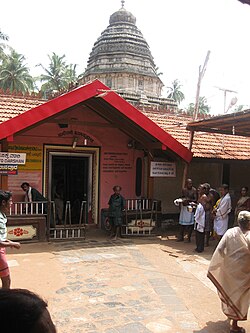Mahabaleshwar Temple, Gokarna
From Wikipedia, the free encyclopedia
| Mahabaleshwar Temple | |
|---|---|
 Mahabaleshwar Temple at Gokarna | |
| | |
| Coordinates: | 14°32′36″N 74°18′59″ECoordinates: 14°32′36″N 74°18′59″E |
| Name | |
| Proper name: | Mahabaleshwar Temple, Gokarna |
| Location | |
| Country: | India |
| State: | Karnataka |
| District: | Uttara Kannada District |
| Locale: | Gokarna |
| Architecture and culture | |
| Primary deity: | Lord Shiva |
| Important festivals: | Shivaratri Rathyatra |
| Architectural styles: | Dravidian architecture |
| History | |
| Date built: (Current structure) | 345 - 365 CE |
| Creator: | Mayuravarma of Kadamba |
The temple, built in a classical Dravidian style of architecture, was first constructed by Mayurasharma of the Kadamba dynasty, who ruled between 345 – 365. This king wanted to gain knowledge of the Vedic rites and the Ashwamedha Yagna (a horse sacrificial ritual), so he travelled to Kanchipuram, a major learning centre, but on reaching there, was insulted by a horseman guard and angry, he swore to defeat the Pallava dynasty (the then ruling dynasty). Following their defeat, the king asked a few priests to perform a daily yagna to maintain his suzerainty over the region. His son, King Kangavarman brought more Brahmin families from different lineages to maintain administration at the temple. Kalidasa mentions the "Lord of Gokarna" in his Raghuvamsha of the 4th century. The Gokarnam shrine is one of the Paadal Petra Sthalams of the 7th century Tevaram canon. Visvesvaraya of Halasunadu-Kundapura built the Chandrasala and Nandi pavilions when Queen Chennammaji and her son Soma sekharanayaka were ruling Keladi (1653-1671). The temple is a large complex of shrines and much of it belongs to the later Vijayanagara period. In 1665, Shivaji came here to worship the deity.
According to the legend, the Atmalinga was perforce placed at Gokarna, in the temple precincts where it is presently deified, by Ravana, the demon King of Lanka of epic Ramayana fame when he carried it from Mount Kailash in the Himalayas. Pilgrims take a holy dip in the Arabian Sea before visiting the temple for worship.[2][3][4] It is one of the seven sacred Muktikshetras or Mukthistala (place of salvation) in India where many Hindus of Karnataka perform obsequies (death rites) for their departed; six other Muktistalas in Karnataka are: Udupi, Kollur, Subrahmanya, Kumbasi, Kodeshvara and Sankaranarayana.[5][6]


No comments:
Post a Comment